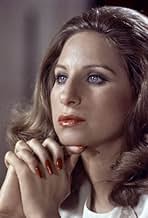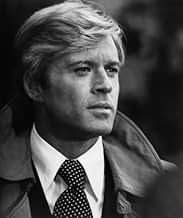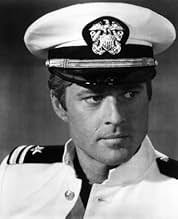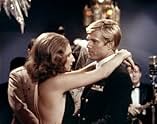CALIFICACIÓN DE IMDb
7.0/10
29 k
TU CALIFICACIÓN
Dos personas viven una relación maravillosa, pero sus convicciones políticas los distancian.Dos personas viven una relación maravillosa, pero sus convicciones políticas los distancian.Dos personas viven una relación maravillosa, pero sus convicciones políticas los distancian.
- Dirección
- Guionistas
- Elenco
- Ganó 2 premios Óscar
- 6 premios ganados y 8 nominaciones en total
Opiniones destacadas
There are movies about love being made all of the time. After awhile, they all begin to look the same. However, once in awhile, one is made that truly stands out. THE WAY WE WERE is such a film. This film, mixing love and politics, finds two individuals (Barbra Streisand and Robert Redford) who meet in college, but years pass before a romance blooms. She is an political activist, he's bored by politics. She's stern and serious, he's easygoing and laid-back. Although they love each other deeply, their differences begin to tear them apart. As far as romantic tearjerkers go, they don't get much better than this. Both Striesand and Redford are perfectly cast and their characters are ones in which viewers will grow to love and care about. Many viewers will also appreciate the realistic ending. This is a beautiful film.
I can remember seeing THE WAY WE WERE when I was in high school and being surprised by how much I had enjoyed it. Romances were never really my thing, but I had always enjoyed the work of Robert Redford, so I decided to give it a try. I was floored by the power and beauty of film! My initial reactions to the film were, once again, how natural and charismatic Redford is as the classic example of the college golden boy, who feels slightly trapped. After the credits began to roll, I knew right then that I had seen something special, something that would pass the test of time. I assume others felt the same way, the film went on to become an international blockbuster and the top grosser of the year.
Years later, I watched THE WAY WE WERE again. Now older, I had a new perspective on the film, and to be completely honest, I enjoyed it even more! While I still think Redford is great in this film, I discovered that it is actually Barbra Streisand who gives the better performance. As the political activist Katie, Streisand has one her best roles since Fanny Brice in the original FUNNY GIRL and she provides a show-stopping performance. She displays both strength and vulnerability, she is at once both scorned and innocent. Her's is one of the best performances of the 70's.
The final verdict: THE WAY WE WERE stands the test of time as one of the best films of it's kind. Watch this film for the most moving finale in film history, for the knock out performance from Streisand, for the long-lasting chemistry between Redford and Streisand, and for one of the most famous and touching love stories of this century.
Out of 10, I'd rate THE WAY WE WERE a solid 10!
Years later, I watched THE WAY WE WERE again. Now older, I had a new perspective on the film, and to be completely honest, I enjoyed it even more! While I still think Redford is great in this film, I discovered that it is actually Barbra Streisand who gives the better performance. As the political activist Katie, Streisand has one her best roles since Fanny Brice in the original FUNNY GIRL and she provides a show-stopping performance. She displays both strength and vulnerability, she is at once both scorned and innocent. Her's is one of the best performances of the 70's.
The final verdict: THE WAY WE WERE stands the test of time as one of the best films of it's kind. Watch this film for the most moving finale in film history, for the knock out performance from Streisand, for the long-lasting chemistry between Redford and Streisand, and for one of the most famous and touching love stories of this century.
Out of 10, I'd rate THE WAY WE WERE a solid 10!
I recall a line from The Alamo in which John Wayne says to Linda Cristal that political differences don't make for good breakfast talk between a man and a woman. That's a piece of wisdom that Barbra Streisand and Robert Redford should have remembered for their characters in The Way We Were.
Meet Hubbell Gardiner and Katie Marofsky from the Thirties at Columbia University. Redford as Gardiner is your all American athlete and the Prince Charming of many a young girl's dreams. An elegant WASP Ivy League future is in store for him if he wants it.
One of those girls who thinks Redford is Prince Charming is Barbra Streisand as Katie Marofsky. She's a member of the young Communists and is one eloquent campus radical for her cause. When we see her she's got a picture of Lenin in her dormitory room. We see her talking about the cause of Republican Spain and the budding young Ivy League Republicans on the campus are hooting her down. All, but Redford who's impressed by her convictions even if he doesn't share them.
But when the USA does get into World War II and Redford is in the Navy and Streisand now working for the Office of War Information now meet. Politics seem to take a back seat to romance and Streisand lives out a real life fairy tale as a Brooklyn Jewish Cinderella.
Their love gets really tested in the post World War II period during the Red Scare. Streisand's not quite the Communist she once was, a picture of FDR is now in her room. That was in fact one of FDR's main contributions to our body politic, winning over budding revolutionaries like Streisand to support our democratic, (big and small "D") way of life. But he's gone now and the Soviet Union has become our cold war enemy. A lot of people are now caught in the post war reaction.
Because Hollywood is the glamor capital of the world and right-wing politicos can't get any mileage out of investigating Communist plumbers, it's to the movie capital that the House Un-American Activities Committee turns. Redford is now working in that industry as is Streisand.
Redford sees the problem in personal terms, Streisand sees the big picture, but that's all she does see. How things resolve themselves is the basis of The Way We Were.
With all the political differences there beats the heart of one of the best love stories ever done in Hollywood. When Redford's around, Streisand lights up the screen with her passion for him. But it never quite covers the different world views they have.
With such detail given to the stars by director Sydney Pollack, the supporting cast and it's a good one, never really establish their characters. Maybe that's what he wanted, to have them appear as plastic as Streisand's Katie Marofsky thinks they are.
The Way We Were contains the title song written by Marvin Hamlisch and Alan and Marilyn Bregman which became one of Streisand's best loved ballads. Her singing of that song is unforgettable whether heard on record or if fortunate, live at one of her concerts. Bing Crosby also made a nice recording of it for one of his last albums. Hamlisch also won an Oscar for Best overall Musical Score that year, they were the only two Oscars won by The Way We Were.
The sad thing about The Way We Were is that Streisand and Redford hold such different views and yet are fundamentally decent people who cannot agree to disagree. It's what makes The Way We Were such a beautiful, yet ultimately sad film.
Meet Hubbell Gardiner and Katie Marofsky from the Thirties at Columbia University. Redford as Gardiner is your all American athlete and the Prince Charming of many a young girl's dreams. An elegant WASP Ivy League future is in store for him if he wants it.
One of those girls who thinks Redford is Prince Charming is Barbra Streisand as Katie Marofsky. She's a member of the young Communists and is one eloquent campus radical for her cause. When we see her she's got a picture of Lenin in her dormitory room. We see her talking about the cause of Republican Spain and the budding young Ivy League Republicans on the campus are hooting her down. All, but Redford who's impressed by her convictions even if he doesn't share them.
But when the USA does get into World War II and Redford is in the Navy and Streisand now working for the Office of War Information now meet. Politics seem to take a back seat to romance and Streisand lives out a real life fairy tale as a Brooklyn Jewish Cinderella.
Their love gets really tested in the post World War II period during the Red Scare. Streisand's not quite the Communist she once was, a picture of FDR is now in her room. That was in fact one of FDR's main contributions to our body politic, winning over budding revolutionaries like Streisand to support our democratic, (big and small "D") way of life. But he's gone now and the Soviet Union has become our cold war enemy. A lot of people are now caught in the post war reaction.
Because Hollywood is the glamor capital of the world and right-wing politicos can't get any mileage out of investigating Communist plumbers, it's to the movie capital that the House Un-American Activities Committee turns. Redford is now working in that industry as is Streisand.
Redford sees the problem in personal terms, Streisand sees the big picture, but that's all she does see. How things resolve themselves is the basis of The Way We Were.
With all the political differences there beats the heart of one of the best love stories ever done in Hollywood. When Redford's around, Streisand lights up the screen with her passion for him. But it never quite covers the different world views they have.
With such detail given to the stars by director Sydney Pollack, the supporting cast and it's a good one, never really establish their characters. Maybe that's what he wanted, to have them appear as plastic as Streisand's Katie Marofsky thinks they are.
The Way We Were contains the title song written by Marvin Hamlisch and Alan and Marilyn Bregman which became one of Streisand's best loved ballads. Her singing of that song is unforgettable whether heard on record or if fortunate, live at one of her concerts. Bing Crosby also made a nice recording of it for one of his last albums. Hamlisch also won an Oscar for Best overall Musical Score that year, they were the only two Oscars won by The Way We Were.
The sad thing about The Way We Were is that Streisand and Redford hold such different views and yet are fundamentally decent people who cannot agree to disagree. It's what makes The Way We Were such a beautiful, yet ultimately sad film.
The theme of a golden boy falling for a girl from "another world", be it social class, the "wrong side of the tracks" or fill in your cliché here, is one that goes back to the silent film era. One of the most famous examples is Sydney Pollack's 1973 film "The Way We Were". Set from the 1930's through the 1950's, Barbra Streisand plays Katie, an outspoken member of the Communist party and campus activist who does not have anything handed to her; she works two and sometimes three jobs in order to pay for her living and college tuition. Hubble (Redford) is your typical aforementioned golden boy, a "big man on campus" who indulges in sports, debutantes and all-around good times. The two know each other from the diner Katie works at (he being the patron) and at one point before graduation, briefly bond over their shared passion for writing. Cut to a few years in the future and Katie encounters Hubble at a bar. Hubble is in the armed forces and Katie is characteristically working a couple of jobs while volunteering for various social causes. After a night of drunken sex (Hubble being the drunken one) they embark on an unlikely relationship that spans over a decade and includes a move to California (when Hubble becomes a screenwriter in Hollywood) and the conception of one child. They are happy, but realize that regardless of their desire, they can't completely cross social lines and certainly can't change one another, particularly Katie's ever-ferocious dedication to social causes; a fight that becomes exponentially heated during McCarthy's Red Scare. The two have to decide whether they can sustain enough raw emotion for one another to persevere over everything else that is stacked up against them.
There are several things about "The Way We Were" that require suspension of disbelief (the fact that despite never having had much contact with one another that after one night of drunken lust and an awkward "morning after" being enough to kick start a relationship the magnitude of theirs is the first thing that comes to mind) but the bottom line is that it really is a well-written, well-directed and well-acted film. The two principal characters are full and complex, regardless of whether we are talking about the socially conscience Katie or the socially acceptable Hubble. I suspect they somewhat were written with the intent of familiarity for the purpose of effectiveness, and if this is true, it worked on me. The era in which these two characters were set was a very interesting time in American history, and the characters' actions during these times created some compelling cinema, particularly when it touched on the Red Scare.
But who am I fooling? The main reason people watch this movie, whether for the first time or for the fiftieth is for the doomed romance, and Streisand and Redford deliver in spades. "The Way We Were" was written for Streisand, (something that cause Redford to turn down the part at first, because he knew the film was going to be hers) and her portrayal of Katie is excellent. There are so many perceptions of Streisand nowadays (some of them correct, to be sure) that it's easy to forget that she really does have some serious acting chops, and she exhibits them to full effect here. I also happened to learn that the soft filtered lens thing with her didn't just start with her later movies, for whatever reason she was filmed with that lens more often than not here, but that didn't do anything more than slightly distract me because I couldn't help but chuckle. Redford gives a typical solid performance as well, though his initial doubts about taking the role turned out to be valid; he is not the dynamic figure in the film. However, his character is a strong one and Redford does a good job.
I don't know if Pollack knew he was creating a screen classic when he directed "The Way We Were" but he did make a very good film. If you can make it past some major melodrama and some plot holes (what was the deal with their child?) watch this film, and just sit back and appreciate it for what it is a chick flick that guys don't have to feel ashamed watching. 7/10 --Shelly
There are several things about "The Way We Were" that require suspension of disbelief (the fact that despite never having had much contact with one another that after one night of drunken lust and an awkward "morning after" being enough to kick start a relationship the magnitude of theirs is the first thing that comes to mind) but the bottom line is that it really is a well-written, well-directed and well-acted film. The two principal characters are full and complex, regardless of whether we are talking about the socially conscience Katie or the socially acceptable Hubble. I suspect they somewhat were written with the intent of familiarity for the purpose of effectiveness, and if this is true, it worked on me. The era in which these two characters were set was a very interesting time in American history, and the characters' actions during these times created some compelling cinema, particularly when it touched on the Red Scare.
But who am I fooling? The main reason people watch this movie, whether for the first time or for the fiftieth is for the doomed romance, and Streisand and Redford deliver in spades. "The Way We Were" was written for Streisand, (something that cause Redford to turn down the part at first, because he knew the film was going to be hers) and her portrayal of Katie is excellent. There are so many perceptions of Streisand nowadays (some of them correct, to be sure) that it's easy to forget that she really does have some serious acting chops, and she exhibits them to full effect here. I also happened to learn that the soft filtered lens thing with her didn't just start with her later movies, for whatever reason she was filmed with that lens more often than not here, but that didn't do anything more than slightly distract me because I couldn't help but chuckle. Redford gives a typical solid performance as well, though his initial doubts about taking the role turned out to be valid; he is not the dynamic figure in the film. However, his character is a strong one and Redford does a good job.
I don't know if Pollack knew he was creating a screen classic when he directed "The Way We Were" but he did make a very good film. If you can make it past some major melodrama and some plot holes (what was the deal with their child?) watch this film, and just sit back and appreciate it for what it is a chick flick that guys don't have to feel ashamed watching. 7/10 --Shelly
Barbra Streisand and Robert Redford look wonderful in this great story of doomed love. Character development (or arc) is supposed to be one of the basic elements of a good screenplay; but the whole point of Sydney Pollack's 1973 movie is that neither Katie Moroski nor Hubbell Gardner changes. She remains the serious-minded Jewish left-wing activist, and he the easy-going, politically uncommitted WASP, they are when they first meet in college in 1937. Fascinated with each other precisely because they are such opposites, they have an affair, marry and have a baby; but their inability to compromise - or in his case to stop compromising - leads to break-up.
The main action spans the eventful decade from the Spanish Civil War and New Deal, through WWII, to the McCarthy era, by which time Katie and Hubbell have moved from New York to Hollywood, where he is a screenwriter. Though melodramatic and sketchy, the political dimension of the story should not be underestimated; this is one of the very rare American movies in which a communist is treated sympathetically. Presumably much of this side of the scenario stemmed from the personal experience of writer Arthur Laurents, who was the same age as his protagonists, and who had McCarthy-related problems.
Both stars are perfect for their roles; we can see what they see in each other; and we desperately want it to work for them, though we know it won't! Notable in support are Bradford Dillman, Lois Chiles, and James Woods. The theme song, emotionally delivered by Streisand as only she can, is beautiful, but the relevance of its nostalgic lyric to this clear-eyed movie is doubtful.
The main action spans the eventful decade from the Spanish Civil War and New Deal, through WWII, to the McCarthy era, by which time Katie and Hubbell have moved from New York to Hollywood, where he is a screenwriter. Though melodramatic and sketchy, the political dimension of the story should not be underestimated; this is one of the very rare American movies in which a communist is treated sympathetically. Presumably much of this side of the scenario stemmed from the personal experience of writer Arthur Laurents, who was the same age as his protagonists, and who had McCarthy-related problems.
Both stars are perfect for their roles; we can see what they see in each other; and we desperately want it to work for them, though we know it won't! Notable in support are Bradford Dillman, Lois Chiles, and James Woods. The theme song, emotionally delivered by Streisand as only she can, is beautiful, but the relevance of its nostalgic lyric to this clear-eyed movie is doubtful.
¿Sabías que…?
- TriviaFilmed amid the ongoing Watergate political scandal, Robert Redford initially wanted the film to focus on the blacklisting of actors and writers during the McCarthy era. He was unhappy with cuts made to the film following a preview. "I think we'd both have preferred a more political Dalton Trumbo-type script," Redford recalled, "but finally Sydney came down on the side of the love story. He said, 'This is first and foremost a love affair,' and we conceded that. We trusted his instincts, and he was right."
- ErroresWhen the radio announcer refers to the time of Franklin Roosevelt's death, he says it occurred at 5:45 in the morning. President Roosevelt died in the early afternoon.
- Citas
Hubbell Gardner: People are more important than their principles.
Katie Morosky Gardner: People ARE their principles.
- ConexionesFeatured in Film Extra: Sydney Pollock (1973)
- Bandas sonorasThe Way We Were
Composed by Marvin Hamlisch
Lyrics by Marilyn Bergman and Alan Bergman
Sung by Barbra Streisand before the opening credits and during the end credits.
Music played often in the score
Selecciones populares
Inicia sesión para calificar y agrega a la lista de videos para obtener recomendaciones personalizadas
Detalles
- Fecha de lanzamiento
- País de origen
- Idiomas
- También se conoce como
- Cherie Bitter
- Locaciones de filmación
- Productoras
- Ver más créditos de la compañía en IMDbPro
Taquilla
- Presupuesto
- USD 5,000,000 (estimado)
- Total en EE. UU. y Canadá
- USD 45,000,000
- Total a nivel mundial
- USD 45,000,493
Contribuir a esta página
Sugiere una edición o agrega el contenido que falta

Principales brechas de datos
By what name was The Way We Were (1973) officially released in India in Hindi?
Responda









































